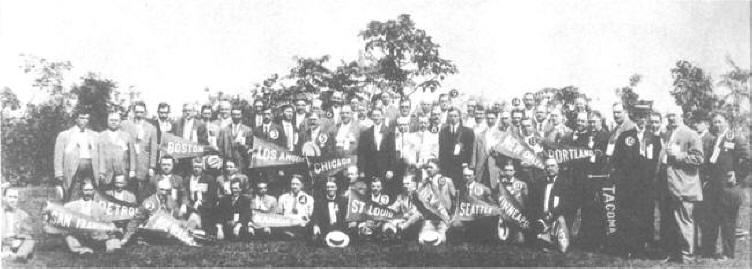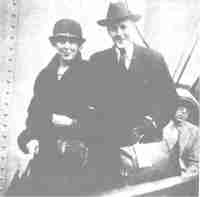|
Then and Now: Rotarians On The Move
Swiftly, swiftly flew the ship,
Yet she sailed softly too :
Sweetly, sweetly blew the breeze--
On me alone it blew.
- Samuel Taylor Coleridge
“The Rime of the Ancient Mariner.”
In this century of mass air travel, instant communication and
lasting friendships made without any face-to-face contact, it is not
easy to comprehend the difficulties that confronted our Rotary
forebears in communicating with each other and in travelling to
Conventions.

Messages were conveyed by mail which could take more than 30 days to
travel from one hemisphere to their destination in the other. The
fastest means of communication was by telegraph. No internet, nor
cell phones, nor Blackberries in those simpler times. Of necessity,
letters were precise in their meaning and carefully phrased,
although, reading them today we view them as stilted in their
construction and grammar. How, one wonders, will future generations,
accustomed to text messaging, and whatever yet to be devised
electronic devices, adequately communicate across language barriers.
Before the advent of mass air travel, intense cross-border security,
lengthy queues at airline terminals and the convenience of the
ubiquitous credit card; travellers cheques or letters of credit
issued by banks were the means of accessing foreign currency. Travel
was by steamship and railroad. Journeys from countries such as
Australia and New Zealand to the West Coast of the United States
took eighteen days and to Great Britain thirty-one at best. The cost
in time and money to those dedicated Rotarians who made the odysseys
to Conventions was not inconsiderable as they were away from their
businesses and professions for up to three months.
 It is documented
that the British Rotarians attending the
1930 Convention in Chicago
sailed from Southampton on June 7 and on arrival at New York then travelled to Chicago via Philadelphia and Washington, arriving in
Chicago on June 22. Following the Convention they returned to
Britain via Toronto and Montreal in Canada, eventually arriving in
England on July 7. In many cases, those forays possibly constituted
annual holidays, but they also were a valuable opportunity to
establish friendships within the group as well as with Rotarians in
other lands, thus establishing the firm bonds in Fellowship that is
Rotary’s strength. It is documented
that the British Rotarians attending the
1930 Convention in Chicago
sailed from Southampton on June 7 and on arrival at New York then travelled to Chicago via Philadelphia and Washington, arriving in
Chicago on June 22. Following the Convention they returned to
Britain via Toronto and Montreal in Canada, eventually arriving in
England on July 7. In many cases, those forays possibly constituted
annual holidays, but they also were a valuable opportunity to
establish friendships within the group as well as with Rotarians in
other lands, thus establishing the firm bonds in Fellowship that is
Rotary’s strength.
The protracted confinement aboard ships without sight of land for
days on end, and in railway coaches provided the opportunity for
serious discussion on matters Rotary. We may reasonably conclude
that those discussions were the source of many of the decisions that
were subsequently made by Rotary’s early Boards of Directors,
decisions that were promulgated in clear and precise language which
left little room for loose interpretation. An examination of old
Manuals of Procedure shows them to resemble an Army general’s Order
of the Day, issued before a battle; they provided only limited scope
for interpretation by the District Governors as commanders in the
field.
We should have sympathy and admiration for those hardy travellers of
the past. They did not wear jeans, T-shirts, sports shoes and
windbreakers. Suits, collars, ties, highly polished dress shoes,
hats and overcoats were de rigueur. They knew nothing of soft fabric
suitcases fitted with wheels and retractable handles. Their
belongings were packed in stout, heavy rawhide suitcases and
sometimes “cabin trunks,” large hinged boxes which stood on end and
when opened out revealed drawers on one side and hanging space for
garments on the other. In hotel rooms, guests’ shoes were put
outside the door at night to be collected by a porter, cleaned and
polished, then returned before guests awoke in the morning.
 It was thus encumbered that Paul and Jean Thomson Harris made their
many journeys about the world promoting Rotary and one can but
marvel at the fortitude and commitment of that frail man and his
devoted wife. It is little wonder that after Paul’s death and Jean
had returned to her native Scotland, when invited to attend a Rotary
function in Edinburgh, she declined, saying that she did not care to
attend another Rotary meeting for the rest of her life. It was thus encumbered that Paul and Jean Thomson Harris made their
many journeys about the world promoting Rotary and one can but
marvel at the fortitude and commitment of that frail man and his
devoted wife. It is little wonder that after Paul’s death and Jean
had returned to her native Scotland, when invited to attend a Rotary
function in Edinburgh, she declined, saying that she did not care to
attend another Rotary meeting for the rest of her life.
Norm Winterbottom
RC Katikati, NZ (D-9930)
|



 It was thus encumbered that Paul and Jean Thomson Harris made their
many journeys about the world promoting Rotary and one can but
marvel at the fortitude and commitment of that frail man and his
devoted wife. It is little wonder that after Paul’s death and Jean
had returned to her native Scotland, when invited to attend a Rotary
function in Edinburgh, she declined, saying that she did not care to
attend another Rotary meeting for the rest of her life.
It was thus encumbered that Paul and Jean Thomson Harris made their
many journeys about the world promoting Rotary and one can but
marvel at the fortitude and commitment of that frail man and his
devoted wife. It is little wonder that after Paul’s death and Jean
had returned to her native Scotland, when invited to attend a Rotary
function in Edinburgh, she declined, saying that she did not care to
attend another Rotary meeting for the rest of her life.